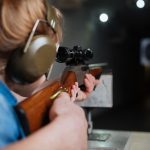Before we embark on the journey of building an indoor shooting range for airguns, it’s paramount to underscore the absolute importance of safety. While airguns can provide a convenient means of practicing shooting indoors, it’s crucial to recognize that not all airguns are suitable for this purpose. However, with the right safety measures in place, you can still refine your skills at shorter distances, which will eventually translate to shooting at longer distances. So, let’s kick off with safety taking the lead in our discussion.
Safety is Everything
We’ve accumulated a significant amount of experience shooting nearly every type of airgun on an indoor 10-meter range. Even a space as small as shooting from the back of your boat bay through to the front of your garage can be sufficient for some quality trigger time. However, before you even think about pulling the trigger, it’s crucial to ensure that you have all the necessary safety measures in place. Safety is the cornerstone of a successful indoor range, particularly if it’s located in your home.
Step 1 – Clear Identification During Use
As you set up your temporary indoor shooting range, one of the first and most crucial steps is to establish clear boundaries. Just as you wouldn’t cross a firing line at a professional range, it’s essential to ensure that everyone present, not just those engaging in target practice, is fully aware of the space and how to conduct themselves around it. Remember, even a small airsoft BB can cause harm, so it’s vital to prevent any accidents that could spoil your fun trigger time.
Step 2 – Capture Your Projectile
Once you have established your designated shooting area, you can focus on your plans to fully capture your projectile. While the use of a steel bullet trap like the Champion Heavy Duty Metal Trap may seem ideal, it doesn’t address lead dust generated from pellet impacts, and inhaling lead dust could be very dangerous. Consider something like the Air Venturi Quiet Pellet Trap w/ Steel Backstop. Not only does it look great, but it’s filled with “impact putty” (electrician’s putty) which captures BBs and Pellets easily. For airguns with a little more power, it includes a steel plate that sits between the putty and the back of the trap. An additional benefit is that the putty is reusable. While it can be tedious, we have a lot of experience digging out bbs and pellets and then remolding the putty to go back into the trap. You can continue to use the putty for many years. We also have replacement putty should you want to start with a fresh batch.
Step 3 – Backup Your Backstop
Once you have whatever you have chosen to use to capture your pellet or BB, consider what’s behind it, should you miss the bullseye. It’s not “if,” it’s “when,” and you want to be prepared for the “when.” You will miss the target at some point. Our last indoor range utilized a two-foot-wide by three-foot-tall back panel comprised of doubled-up 2x4s. We installed a shelf that accommodated our Quiet Pellet trap, placing it about at the center of our backstop. There were times when errant shots missed the trap, and we were extremely grateful to have the extra area to stop our projectiles. Pine 2x4s work pretty well as they are relatively soft and generally absorb pellets if they miss the target. If you are only shooting lower-powered BB pistols or airsoft, you may find that a heavy blanket or carpet remnant will also work.
Step 4 – Create a Checklist for Your Range Setup
Lastly, you’ll want to create a checklist for your range that involves direct verification of all aspects we’ve discussed today. It may look something like this:
- Has everyone been informed that we’ll be shooting from between X and Y today?
- Is the area clearly defined and identified in case someone shows up who hasn’t been informed?
- Does everyone have the required safety gear, i.e., safety glasses?
- Is the pellet trap ready to go, and is the backup backstop sufficient to stop errant shots?
- Has everyone who’s going to be shooting been shown basic gun handling and gun safety, and can they pass a random quiz on the principles?
- Always Keep your Airgun or Firearm Pointed in a Safe direction. Never point your gun at anything you do not intend to shoot.
- Treat All Guns as Though They Are Loaded.
- Keep Your Finger Off the Trigger until You are Ready to Shoot.
- Always Be Sure of Your Target and What’s Beyond It.
Your checklist may vary based on your configuration, but it’s always good practice to double-check your area, gear, and shooters to help ensure a successful time on your indoor range.
Do you have an indoor range? We’d love to know more about it. Please use the comment section to share the details of your range and how it’s worked out for you.
